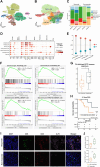Memory/Active T-Cell Activation Is Associated with Immunotherapeutic Response in Fumarate Hydratase-Deficient Renal Cell Carcinoma
- PMID: 38512114
- PMCID: PMC11145163
- DOI: 10.1158/1078-0432.CCR-23-2760
Memory/Active T-Cell Activation Is Associated with Immunotherapeutic Response in Fumarate Hydratase-Deficient Renal Cell Carcinoma
Abstract
Purpose: Fumarate hydratase-deficient renal cell carcinoma (FH-deficient RCC) is a rare and lethal subtype of kidney cancer. However, the optimal treatments and molecular correlates of benefits for FH-deficient RCC are currently lacking.
Experimental design: A total of 91 patients with FH-deficient RCC from 15 medical centers between 2009 and 2022 were enrolled in this study. Genomic and bulk RNA-sequencing (RNA-seq) were performed on 88 and 45 untreated FH-deficient RCCs, respectively. Single-cell RNA-seq was performed to identify biomarkers for treatment response. Main outcomes included disease-free survival (DFS) for localized patients, objective response rate (ORR), progression-free survival (PFS), and overall survival (OS) for patients with metastasis.
Results: In the localized setting, we found that a cell-cycle progression signature enabled to predict disease progression. In the metastatic setting, first-line immune checkpoint inhibitor plus tyrosine kinase inhibitor (ICI+TKI) combination therapy showed satisfactory safety and was associated with a higher ORR (43.2% vs. 5.6%), apparently superior PFS (median PFS, 17.3 vs. 9.6 months, P = 0.016) and OS (median OS, not reached vs. 25.7 months, P = 0.005) over TKI monotherapy. Bulk and single-cell RNA-seq data revealed an enrichment of memory and effect T cells in responders to ICI plus TKI combination therapy. Furthermore, we identified a signature of memory and effect T cells that was associated with the effectiveness of ICI plus TKI combination therapy.
Conclusions: ICI plus TKI combination therapy may represent a promising treatment option for metastatic FH-deficient RCC. A memory/active T-cell-derived signature is associated with the efficacy of ICI+TKI but necessitates further validation.
©2024 The Authors; Published by the American Association for Cancer Research.
Figures




References
-
- Moch H, Amin MB, Berney DM, Compérat EM, Gill AJ, Hartmann A, et al. . The 2022 World Health Organization classification of tumours of the urinary system and male genital organs-part A: renal, penile, and testicular tumours. Eur Urol 2022;82:458–68. - PubMed
-
- Muller M, Guillaud-Bataille M, Salleron J, Genestie C, Deveaux S, Slama A, et al. . Pattern multiplicity and fumarate hydratase (FH)/S-(2-succino)-cysteine (2SC) staining but not eosinophilic nucleoli with perinucleolar halos differentiate hereditary leiomyomatosis and renal cell carcinoma-associated renal cell carcinomas from kidney tumors without FH gene alteration. Mod Pathol 2018;31:974–83. - PubMed
-
- Carril-Ajuria L, Colomba E, Cerbone L, Romero-Ferreiro C, Crouzet L, Laguerre B, et al. . Response to systemic therapy in fumarate hydratase–deficient renal cell carcinoma. Eur J Cancer 2021;151:106–14. - PubMed
-
- Sun G, Zhang X, Liang J, Pan X, Zhu S, Liu Z, et al. . Integrated molecular characterization of fumarate hydratase–deficient renal cell carcinoma. Clin Cancer Res 2021;27:1734–43. - PubMed
-
- Xu Y, Kong W, Cao M, Wang J, Wang Z, Zheng L, et al. . Genomic profiling and response to immune checkpoint inhibition plus tyrosine kinase inhibition in FH-deficient renal cell carcinoma. Eur Urol 2023;83:163–72. - PubMed
MeSH terms
Substances
Grants and funding
- ZYJC21020/1.3.5 project for disciplines of excellence, West China Hospital, Sichuan University
- 2021YFS0119/Sichuan Province Science and Technology Support Program (Science and Technology Project of Sichuan)
- 82303659/National Natural Science Foundation of China (NSFC)
- 2020M673239/Postdoctoral Research Foundation of China (China Postdoctoral Research Foundation)
- 2022NSFSC1526/Natural Science Foundation of Sichuan Province ()
LinkOut - more resources
Full Text Sources
Medical
Miscellaneous

